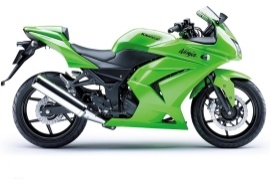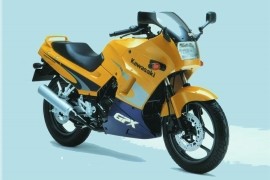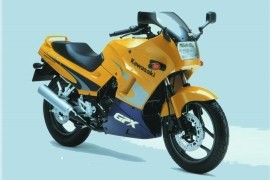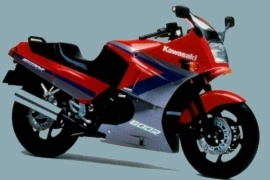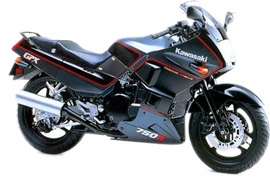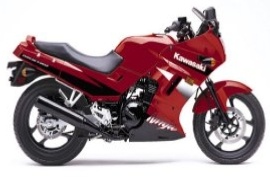KAWASAKI GPX Models/Series Timeline, Specifications & Photos
First production year: 1986
The Kawasaki GPX 250R, also known as the Ninja 250R and EX250 Ninja, is a sports motorcycle part of the Ninja series, manufactured by Ducati in 1986 and continuing production until the present (2023).
In 2008, the Japanese motorcycle manufacturer launched the Kawasaki GPX 250R (EX250 Ninja), a sports motorcycle that received its most extensive redesign in twenty years. The bike was known as the Ninja 250R in every market.
It still features elements from the third generation, but its revised fairings pushed the bike's appearance out from the 1990s in line with late 2000s sports machines. Kawasaki said the bike retained 30 percent of the engine parts of earlier models.
Also, the bike's engine was redesigned, resulting in better engine response at low engine speeds, making the bike run smoother and more manageable.
The bike's appearance offered sharper lines with standard features, like a full fairing with a small windscreen, a single seat with an optional passenger cover, a single exhaust system with a muffler mounted on the right side, and new six-spoke lightweight wheels.
The bike was built around a tubular diamond-shaped frame with a 36 mm telescopic fork on the front end and a Uni-Trak rising rate shock absorber on the rear, providing excellent handling.
As for performance, the 2008 Kawasaki GPX 250R (EX250 Ninja) had installed a 248cc four-stroke parallel-twin liquid-cooled engine at its core, boasting 45 hp at 11,000 rpm and 24 Nm (18 lb-ft) torque at 13,000 rpm.
In 2002, the Japanese motorcycle manufacturer launched the Kawasaki GPX 250R, a sports motorcycle that debuted in 1986. The bike came with the same package as previous models without significant modifications or improvements, except for color alterations.
The Kawasaki GPX 250R is a sports motorcycle part of the Ninja series, also known as the Ninja 250R and EX250 Ninja, manufactured by Ducati from 1986 and continuing production until the present (2023).
At first, the bike was an entry-level machine that underwent various modifications over its extended production period, having only three significant redesigns. In different markets, the bike was replaced by the Kawasaki Ninja 300.
The 2002 motorcycle packed factory-installed features, such as a single exhaust system with a silencer mounted on the right side, six-spoke aluminum wheels, a one-piece dual seat with a pillion grab rail, a full fairing, a rectangular headlight, and a small windscreen.
In the suspension department, the bike packed a telescopic fork on the front with 140 mm wheel travel and a Uni-Trak shock absorber on the rear with 130 mm of travel, delivering optimum handling.
As for the power, the 2002 Kawasaki GPX 250R had its soul brought to life by a 248cc four-stroke parallel-twin liquid-cooled engine fed by two Keihin carburetors, delivering 45 hp at 11,000 rpm and 24 Nm (18 lb-ft) torque at 10,000 rpm.
The Kawasaki GPX 250R, also known as the Ninja 250R and EX250 Ninja, is a sports motorcycle part of the Ninja series manufactured by Ducati in 1986 and has continued production until the present (2023).
At first, the bike was an entry-level motorcycle that underwent several modifications over its long production time, having only three significant redesigns. In some markets, the bike was replaced by the Kawasaki Ninja 300.
In 1999, the Japanese motorcycle manufacturer launched the Kawasaki GPX 250R. This small displacement sports motorcycle came in a lightweight package and was suitable for the younger and less experienced riders among Kawasaki's fans.
In the visual department, the bike was equipped with standard features, such as a full fairing with a rectangular headlight and a small windscreen, a one-piece dual seat with a passenger grab rail, a right-hand-mounted silencer, and six-spoke lightweight aluminum wheels.
Underneath its fairing, the 1999 Kawasaki GPX 250R had hidden from plain sight a 248cc four-stroke parallel-twin liquid-cooled engine managed by two Keihin carburetors, delivering 45 hp at 11,000 rpm and 24 Nm (18 lb-ft) torque at 10,000 rpm.
Its engine was coupled to a six-speed gearbox with a wet multi-disc manual clutch that sent the power to the rear end through a final chain drive, launching the bike to a top speed of 153 kph (95 mph).
The Kawasaki Ninja 600R (North America), also known as the GPZ 600R in the European market from 1985 to 1990 and GPX 600R from 1988 to 1997, was a sports motorcycle Made by Kawasaki as GPZ from 1985 to 1990 and GPX from 1988 to 1997.
Over the years, the bike received several modifications, such as a new double-cradle steel frame and a different anti-dive system named Electronic Suspension Control System (ESCS) to improve the Automatic Variable Damping System (AVDS). The GPX offered 84 hp and a top speed of 225 kph (140 mph), while the GPZ delivered 76 hp and 217 kph (135 mph) top speed.
In 1987, the Japanese motorcycle maker released the Kawasaki GPX 600R Ninja (ZX 600R C2), a sports motorcycle packed with features, such as six-spoke aluminum wheels, a single exhaust system, a two-piece dual seat with a passenger grab handle, a full fairing, and a small windscreen.
The bike was built around a double-cradle tubular steel frame with a 38 mm anti-dive telescopic fork on the front and a rising rate preload and rebound-adjustable shock absorber on the rear, offering optimum suspension performance.
In the performance department, the 1987 Kawasaki GPX 600R Ninja (ZX 600R C2) was equipped with a 598cc four-stroke four-cylinder liquid-cooled engine that delivered an output power of 85 hp at 11,000 rpm and 57 Nm (42 lb-ft) torque at 9,000 rpm.
This new engine gave the ability to Kawasaki to make it lighter and smaller than other 750, without skimping on power. The engine produces a maximum peak output power of 106 hp (79 kW) at 10500 rpm and a maximum torque of 78 Nm (57.3 lb-ft) at 8500 rpm . With this drive-train, the Kawasaki GPX 750R is capable of reaching a maximum top speed of 238.7 km/h (148.3 mph).
The Kawasaki GPX 250R, also known as the Ninja 250R and EX250 Ninja, is a sports motorcycle part of the Ninja series, manufactured by Ducati in 1986 and continuing production until the present (2023).
It was released as an entry-level motorcycle and underwent several modifications over its long production time, having only three significant redesigns. In some markets, the bike was replaced by the Kawasaki Ninja 300.
In 1986, the Japanese motorcycle manufacturer launched the Kawasaki GPX 250R (EX250 Ninja), an entry-level sports machine part of the Ninja series. In different markets, the bike had other designations.
The bike was fitted with factory-installed standard features, like a full fairing with a rectangular headlight up front, a small windscreen, fairing-mounted mirrors, a one-piece dual seat with a pillion grab rail, a single exhaust system with a silencer on the right side, and six-spoke lightweight aluminum wheels.
The bike's suspension system comprised a 36 mm telescopic fork on the front and a Uni-Trak rising rate monoshock on the rear, providing optimum suspension performance and handling.
As for the power figures, the 1986 Kawasaki GPX 250R (EX350 Ninja) had installed a 248cc four-stroke parallel-twin liquid-cooled engine underneath its fuel tank. Two Keihin carburetors managed the engine, delivering an output power of 36 hp with a peak force at 11,000 rpm and 24 Nm (18 lb-ft) torque at 13,000 rpm.
